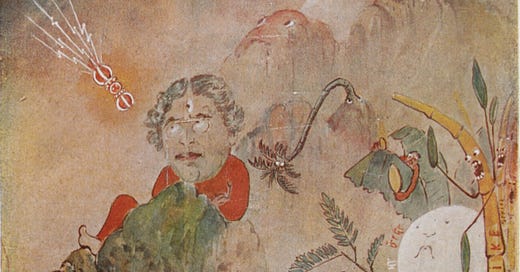Inanimate Scream, Inanimate Nature Responding to the Professor’s Musings (1921), watercolor on paper. From the series of comic sketches, Reform Screams, on the work of Jagadish Chandra Bose, by painter and cartoonist Gaganendranath Tagore. Reproduced in Modern Review, July 1921
In early spring of last year I discovered that plants “cry” when they are deprived of water or injured. Researchers, writing about their experiments with tomato and tobacco plants in the journal Cell, had proved that “stressed plants emit airborne sounds” between 40 and 80 kilohertz, the reason humans cannot hear them. I thought immediately of two things. The first was Jagadish Chandra Bose, a scientist who, working in his lab in colonial Calcutta a hundred years ago, designed instruments to record plant response to various kinds of external stimuli, using a register of emotions reserved almost exclusively for humans. His research was revolutionary, both in thinking to record what he called the plant’s “handwriting” and, even more importantly, in rejecting the adopted dry voice of science journals for a humane vocabulary of thrill, desire, wonder, and love. The second thing I thought of was a joke in my family: how can someone like me—whose strongest pull is toward humor, toward people who make me laugh—be so attracted to plant life, living beings without humor at all?
Jagadish Bose, interested in understanding the “language” of plants, recorded their responses to external stimuli, particularly what he called “injury.” The torulipi—plant script—that his instruments recorded were, quite obviously, of a plant under stress. If recent research proves Bose’s deductions from more than a century ago, that plants “cry,” does it leave out the possibility of laughter in the plant world?
Keep reading with a 7-day free trial
Subscribe to Book Post to keep reading this post and get 7 days of free access to the full post archives.




